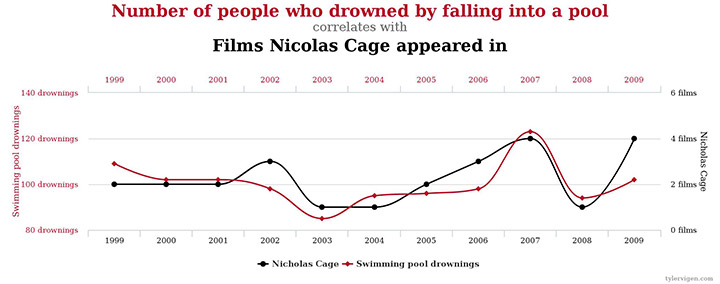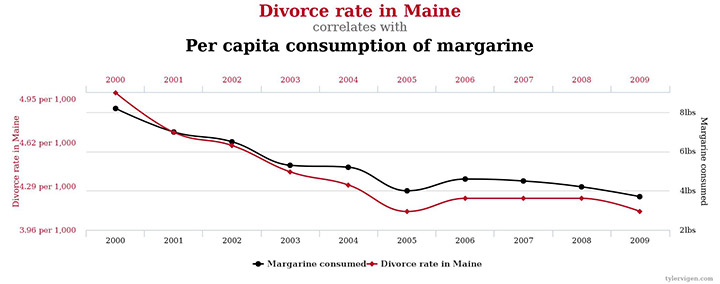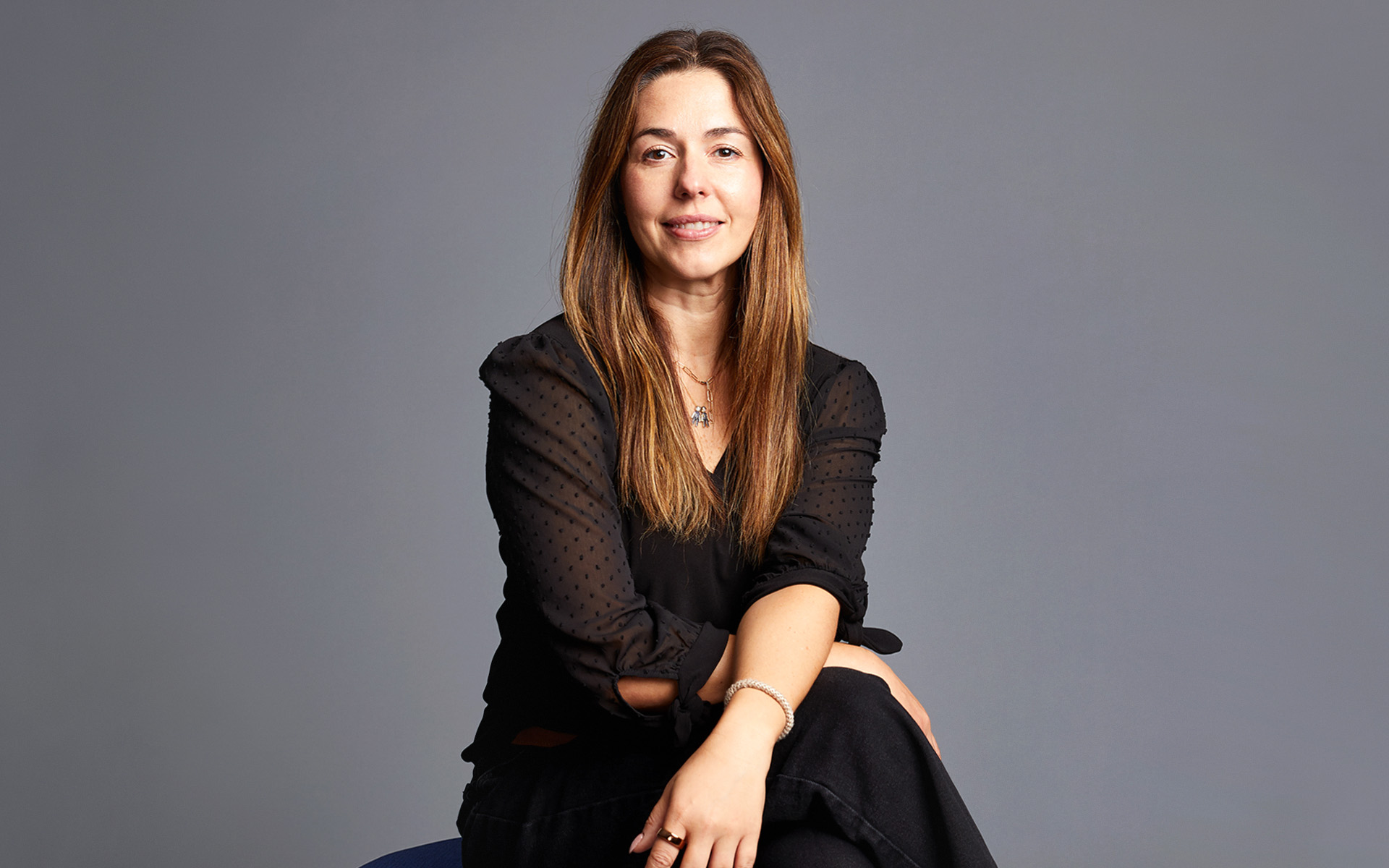We humans love narrative. We know this just from common sense and lived experience, but psychologists have also demonstrated that we think in stories. And one of the key elements of stories is cause and effect: something happens, which makes something else happen.
That might seem obvious, but it has huge implications for the way we make sense of narratives. Take this example from H. Porter Abbott’s The Cambridge Introduction to Narrative:
“Please,” he implored, “give me one more chance!”
Suddenly she felt a headache coming on.
This mini-narrative tells us nothing about the cause of the woman’s headache—it could be low blood sugar, a migraine starting, or low air pressure—but because we are narrative beings, we assume that it’s because of the man’s emotional outburst. We are wired in such a way that we assume that if Event B happens after Event A, then Event A must be the cause of Event B. (Though obviously this isn’t always so; in fact, using this reasoning in an argument is usually a logical fallacy, and even has a Latin name: post hoc, ergo propter hoc, “after it, therefore because of it.”)
Put another way: we want narrative so much that we create them even when they’re not there.
[bctt tweet=”We want narrative so much that we create them even when they’re not there.” username=”berkleeonline”]
And much ado can be made of a connection in time between events that have nothing to do with each other.
Spurious Correlations
Some people have a lot of fun looking for “spurious correlations”—that is, connections between events that have nothing to do with each other, but which provide a hilarious mini-narrative. The joke depends on our assumption that if Event B comes after Event A, then it must have been caused by Event A. These are even collected on Tyler Vigen’s website Spurious Correlations, of course. Here are two of my favorites:


Obviously, there is no actual connection between the number of drownings in swimming pools and the number of films Nicolas Cage appears in—it’s mere coincidence. Nonetheless, it’s funny—albeit darkly so—to imagine that somehow Nic Cage’s film appearances have this kind of power.
Similarly, we can be pretty sure that the divorce rate in the state of Maine has nothing to do with margarine consumption, but it’s fun to imagine otherwise.
Indeed, our love for narrative is such that we not only assume a cause-and-effect relationship, but we even start to think about the mechanisms of that cause. How would margarine consumption affect Maine’s divorce rate? Or is it the other way around? Which is Event A, and which is Event B? (In this case it’s a joke, of course, so it doesn’t matter.)
Even more, we work at great length to make narratives as a way of making sense of the world. Bringing everything together—even events that have nothing to do with one another—helps us to live in a world that could otherwise be confusing or overwhelming. The literary critic Frank Kermode puts it this way:
“If there is one belief (however the facts resist it) that unites us all… it is this conviction that somehow, in some occult fashion, if we could only detect it, everything will be found to hang together.”
So how do we get things to hang together?
One way is what we’ve just looked at, our tendency to create cause and effect wherever we can (and often without knowing we’re doing it).
Another way is by filling in gaps. We do this with narratives of all kinds, and we have to, because narratives are full of them. Here, for example, are the opening two sentences of Ernest Hemingway’s short story “Now I Lay Me”:
“That night we lay on the floor in the room and I listened to the silkworms eating. The silkworms fed in racks of mulberry leaves and all night you could hear them eating and a dropping sound in the leaves.”
Abbott lays out just a few of the many gaps in these two lines:
“Where are we? Why are we lying on the floor? What do silkworms sound like when they eat? What is a “dropping sound”? Is it like the sound of rain? Why can’t or won’t the narrator shut out the sound of the silkworms? If he (is it a he?) listens “all night,” why is he staying awake?”
We learn the answers to some of these questions as we continue to read. Some of the details allow us to infer that the story takes place during World War I, and that the narrator is somewhere in Italy. But we are not told more about the sound of silkworms eating, so we must guess at that ourselves, based on whatever experience we might have with silkworms; if we have no experience, as is likely for most people, then we invent something in our minds. And when we learn later in the story that the narrator is lying “on blankets spread over straw,” we likely intuit that he is in a barn or some other makeshift structure; we construct a mental image of that structure based, most likely, on other barns or similar buildings we know.
And on we go, finding and filling gaps as we proceed.
Filling these gaps is what gives narrative its dynamic quality: it propels the narrative forward because it calls on us, the reader/listener/viewer, to actively participate in the text itself. This is one of the reasons that it can be so odd to see a film or TV version of a book you have read: you have imagined what characters look and sound like, what their environment looks and sounds like, and so on, and when you see someone else’s idea of those looks and sounds, they can clash with your own.
But careful gapping can be powerful, too. Much of what makes the (in)famous horror movie The Blair Witch Project (1999) so terrifying is that the viewer is shown absolutely nothing scary at all. We hear screams; we see eerie objects, and so on, but we never see any witch, any monster, any bad guy. Our imaginations are left to fill in the gaps of what we are presented: what could be making them scream like that? What are they seeing that is making them react with such horror?
In this three-minute clip, three student filmmakers deep in the woods are awakened by their tent being shaken by some unknown (and unseen) force. They leave the tent to investigate. (Note: this clip has quite a bit of the profanity one would expect of those being tormented by malevolent, supernatural forces, so feel free to skip this one if you prefer.)
It’s usually ineffective to have too many gaps, because it is confusing. As an audience, we need some signposts to help guide our experience. And when there are too few gaps, the narrative lurches to a halt and becomes boring; if you have a friend who tells stories by providing every conceivable detail, you probably know what I mean. Likewise, one of the least-loved chapters in Melville’s epic novel Moby Dick is titled “Cetology,” and presents a 5,000-word classification of different whales. Too much detail—too few gaps—gets very, very dull.
One of the assigned readings for this week, from Scott McCloud’s excellent book Understanding Comics, shows how we do this with the sequential art of comics (he calls the process “closure,” which, by the way, he uses with a different meaning from the way narratologists use it), and the same principles work with almost any other narrative art form as well. As McCloud writes, “Every act committed to paper by the comics artist is aided and abetted by a silent accomplice. An equal partner in crime known as the reader.” The reader’s job is to fill the gaps—whether those gaps are the graphical ones like the gutters in comics, or the gaps of meaning in a string of words.
Song lyrics present a unique case because they are not really poetry, nor are they prose. Yet most if not all song lyrics aim to narrate a story. Some of these are explicit about this; the term “ballad” (which now often refers to a slow-tempo song) originally meant a song that related a story. Gordon Lightfoot’s 1976 song “The Wreck of the Edmund Fitzgerald,” for example, narrates the story of a freighter which sank in Lake Superior during a November storm in 1975, killing all 29 crew members.
Listen to the song “The Wreck of the Edmund Fitzgerald” below.
The stories of other songs are typically more fragmentary, and require more work of the listener/audience to make sense of them.
EXAMPLE 1: The Divine Comedy, “I Like,” from the 2010 album Bang Goes the Knighthood
The first verse looks like this:
I like your nose, I like your hair
I like you clothed, I like you bare
I like your boots, your skirts, and your blouses
I like your suits, your shirts, and your trousers
I like your mild political stances
I like your wild spontaneous dances
I like the way you drive me insane, morning, noon, and night
There are all kinds of gaps that need filling here. The repetition of “I” and “you” or “your” cries out to the listener to fill in who those pronouns refer to, and the rest of the song lyrics will tell us nothing beyond the obvious: the “you” appears to be a woman (hence the “skirts and blouses”), while the ‘I’ could be anyone else.
The delineation of the things that the narrator likes about the beloved—nose, hair, and so on—invite us to fill in for ourselves what that nose, hair, and so on looks like. In effect, this adorable song gives us the opportunity—requires us, in fact—to construct that other person.
And at the same time this beloved figure can’t be just anyone, since she has mild political stances and does wild dances. But still, we imagine what both of those look like, along with what behaviors or words drive the smitten narrator “insane” all day long.
EXAMPLE 2: The Hold Steady, “Hurricane J,” from their 2010 album Heaven Is Whenever.
The opening verse and chorus look like this:
VERSE
Jessie, I’m not joking around
I see the crowd you’re hanging with and those kids don’t seem positive
Don’t all the cigs make you tired?
You know I’ll never ask you to change, I’ll only ask you to try
I know you’re gonna do what I know you’re gonna do
But 22 and banging around in restaurants
Isn’t that much prettier than banging around in bars
And why do you keep going to his car?
CHORUS
I don’t want this to stop, I want you to know
I don’t want you to settle, I want you to grow
Forget all the boys that you had at the harbor
They’re too hard already, they’ll only get harder
This song is clearly a narrative, at least in some sense. There are characters, for example: the unnamed narrator; Jessie; the crowd she’s hanging out with; “the boys at the harbor,” and so on. But we don’t know anything about them, at least at first. We don’t even know if Jessie is a man or a woman until later in the lyrics, where the narrator says “You’re a beautiful girl”; likewise, we don’t know that the narrator is a man until that same later line, which concludes “But Jessie, I don’t think I’m the guy.”
Likewise, we know that there are some events, the key to any narrative. Jessie has hung out with some crowd the narrator doesn’t approve of. She will soon do something (which the narrator says he knows she’s gonna do), though we don’t know what exactly. She has gone to some guy’s car, too.
But we don’t know a lot more than this, and a lot of questions remain.
Who is smoking “all the cigs”? Jessie herself, or some of the kids in that crowd? Who is “that crowd,” anyway? Whose car is it that Jessie keeps going to? What is she doing there? Does the narrator know why she keeps going to it, and is asking her the question rhetorically, or is his inquiry genuine? What does the narrator mean by “I don’t want you to settle”—settle down, or settle for something less than she deserves?
We make sense of this song by filling in some of these gaps, though probably not all of them. For the crowd of kids who “don’t seem positive,” we likely imagine some group we have seen in real life or in TV or films. For Jessie herself, we might well picture someone we know, or someone we imagine. Even without meaning to, we will almost certainly fill in “the harbor” with some location we know, and the car that Jessie goes to is, if we think about it, some specific car we know. We probably imagine Jessie and the narrator speaking somewhere specific, and that location might change as the lyrics of the song unfold. When, in the second verse, the narrator says “Jessie, let’s go for a ride. I know a place that we can stop, I know a place that we could drink and kiss for a while. I know a place that always makes you smile,” we fill in the gap: where is that place they stop? Is it a place we ourselves know? The reasons it makes Jessie smile is likely a reason that a place makes us smile, or makes someone we know and love smile.
Meanwhile, we fill in the gaps in the cause-and-effect of the events as well. For example, when the song starts we seem to be dropped into the middle of a conversation: what has the narrator said, and how has Jessie responded to it, that would make the narrator say “I’m not joking around”? Did the narrator start this little lecture to Jessie before the lyrics began, and Jessie laughed it off? What is the “this” in “I don’t want this to stop”—a romantic relationship between the narrator and Jessie? What has Jessie done that makes the narrator feel compelled to tell her “to grow”?
We fill in all of these gaps at once, and our gap-filling leads to an interpretation. For example, we might intuit that the narrator is an older man, which explains why he makes specific mention of Jessie’s age of 22 and feels justified in referring to what is likely—but not certainly! Another gap!—a group of her peers as “kids.” As the song progresses, we learn more about the characters and the actions, which helps us to fill in some gaps but also exposes new ones.
In the second verse, the narrator says “I know you’re gonna say what I know you’re gonna say. I know you’ll look at the ground, I know you’ll probably cry. You’re a beautiful girl and you’re a pretty good waitress, but Jessie, I don’t think I’m the guy.” We know, then, that Jessie is a waitress, and that she’s beautiful… or at least that the narrator wants Jessie to think that the narrator thinks she’s beautiful. (We can’t always take the narrator’s word at face value, of course.) And we know that the narrator and Jessie seem to have some kind of relationship, given that he seems confident in saying that he knows what she’ll say, and that she’ll cry. But new gaps emerge: why is Jessie looking at the ground? Is she shy, ashamed, angry? Likewise, why will she probably cry? What kind of conversation are they having?
Listeners and readers rarely think about these gaps consciously: filling in such gaps is deeply intuitive to us, so we don’t have to think about it consciously. But we do it with so little effort that we can forget that other listeners and readers fill in gaps differently, sometimes leading to radically different interpretations of songs than the ones we ourselves have.
As the literary scholar Wolfgang Iser puts it: “one text is potentially capable of several different realizations, and no reading can ever exhaust the full potential, for each individual reader will fill in the gaps in his own way, thereby excluding the various other possibilities; as he reads, he will make his own decision as to how the gap is to be filled”
Courtney Barnett’s 2015 song, “Depreston,” is a great recent example of requiring listeners to fill in gaps. Take a listen below and hear how the narrator fills in the gaps herself by what she is noticing around her and gradually tuning out the realtor. After listening to the song below, hear Barnett explain on the fantastic series Song Exploder here.
And now it’s time for the headliner: The guy whose mug probably made you click on this link in the first place. The best example of a song with the most evocative blanks to fill in is Phil Collins’ “In the Air Tonight” (from 1981’s Face Value). We’re presenting it here with the lyrics, because we’ve already put Phil’s face on the top of this post, and it’s helpful to see the wide open spaces in the narrative as he sings the song.
In addition to its use in 1980s TV and its gargantuan drum break, this song is particularly famous for engendering an enormous number of theories and urban legends about its meaning, the most common of which asserts that Collins witnessed a person failing to help someone drowning, and that the song is about that incident. (Some of the more far-fetched rumors include Collins gifting the perpetrator a front-row ticket to his concert, where he debuted the song and shined the spotlight on the wrong-doer.)
Collins himself has asserted “I don’t know what this song is about. When I was writing this, I was going through a divorce. And the only thing I can say about it is that it’s obviously in anger. It’s the angry side, or the bitter side of a separation.”
Why did this song create so many myths? Its mood is solemn, even mysterious, and its lyrics are replete with gaps of meaning: it invites the listener to try to make sense of it.
As we have seen, we are narrative beings who want to create cause and effect, even when there is none there.
This post was excerpted from Robert Lagueux‘s Berklee Online class, Music, Self, and Society.











